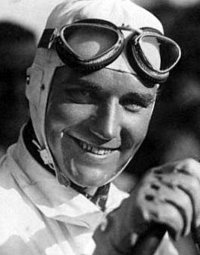Manfred von Brauchitsch
Manfred von Brauchitsch (15 August, 1905 - February 5, 2003) was a German auto racing driver who drove for Mercedes-Benz in the famous "Silver Arrows" of Grand Prix motor racing in the 1930s.
Although an excellent driver who had reasonable success, he struggled with bad luck, and was overshadowed by his more successful Mercedes-Benz team-mates Rudolf Caracciola and Hermann Lang.
Racing career
He won three Grands Prix - the 1934 ADAC Eifelrennen which saw the first appearance of Silver Arrows Mercedes Race cars, the 1937 Monaco Grand Prix (considered his greatest victory), and the 1938 French Grand Prix. His fastest lap in the 1937 Monaco race (1 minute 46.5 seconds, 11.9 seconds faster than the old record lap) set a record that stood for 18 years!
He was twice runner-up in the European Championship, in 1937 and 1938, and finished third in 1939.
He was noted for his red helmet and his bad luck, losing a number of other Grands Prix when he was on the very verge of winning (no less than five, by some counts). His most famous loss was the 1935 German Grand Prix, when a tire blew while he was leading the last lap, handing victory to Tazio Nuvolari in an Alfa Romeo in one of the latter's most famous victories - the only time during the reign of the Silver Arrows when a Grand Prix was won by a car other than a Mercedes or Auto Union.
Personal life
He was born in Hamburg, of an old military family (his uncle was the famous World War II general Walther von Brauchitsch). He entered the German Army after World War I, but after a serious accident he was invalided out in 1928.
Due to his many racing injuries, he was rejected for military service in World War II. While working during the war, he met his first wife, Gisela. After the war, in 1955 he defected to East Germany after various legal problems; Gisela committed suicide a year later.
He later remarried, to Lieselotte; they were later permitted to occasionally visit West Germany.
Further reading
- Chris Nixon, Racing the Silver Arrows: Mercedes-Benz versus Auto Union 1934-1939 (Osprey, London, 1986) pp. 82-91
